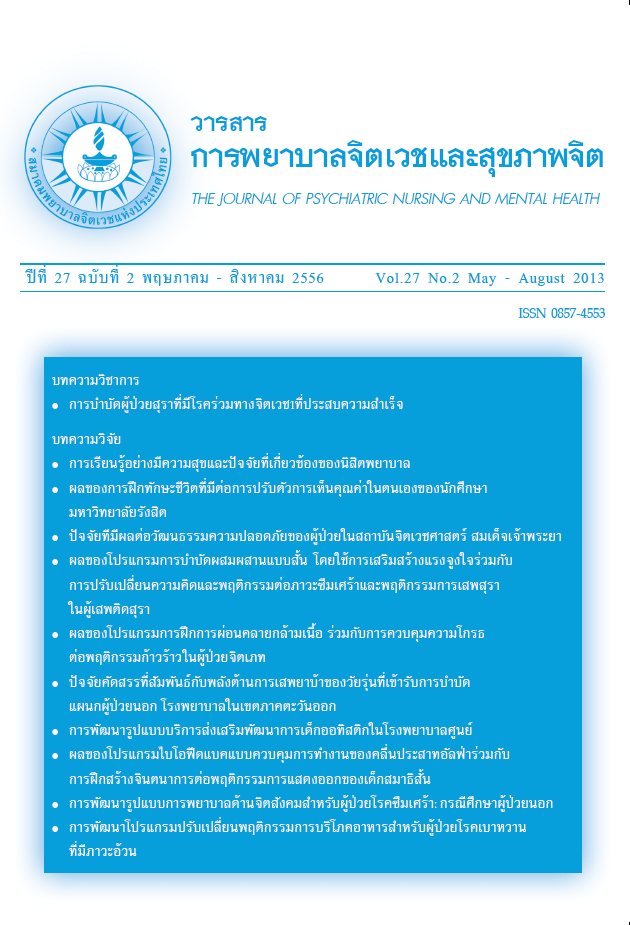การพัฒนารูปแบบการพยาบาลด้านจิตสังคมสำหรับผู้ป่วยโรคซึมเศร้า: กรณีศึกษาผู้ป่วยนอก
Main Article Content
บทคัดย่อ
การศึกษาครั้งนี้มีวัตถุประสงค์เพื่อพัฒนารูปแบบการพบาบาลด้านจิตสังคมสำหรับผู้ป่วยโรคซึมเศร้า แบบผู้ป่วยนอก เป็นการศึกษาแบบกรณีศึกษาการระหว่าง วันที่ 1ตุลาคม 2552 – พฤษภาคม 2554 การศึกษาแบ่งออกเป็น 3 ระยะได้แก่ ระยะที่ 1 การวิเคราะห์สถานการณ์ กลุ่มตัวอย่างเป็น พยาบาลวิชาชีพจำนวน 8 คน ผู้ป่วย/ญาติ 19 คน รวมถึงเอกสารที่เกี่ยวข้อง เก็บรวมรวมข้อมูลโดยการสัมภาษณ์ การสนทนากลุ่ม และการทบทวนเอกสาร วิเคราะห์ข้อมูลด้วยการวิเคราะห์เนื้อหา ระยะที่ 2 นำข้อมูลที่ได้จากข้อค้นพบในระยะที่ 1 มาวางแผนพัฒนารูปแบบการพยาบาลด้านจิตสังคมสำหรับผู้ป่วยโรคซึมเศร้านำแผนที่วางไว้มาปฏิบัติ ประชุมสะท้อนการปฏิบัติและปรับปรุงจนได้รูปแบบการพยาบาลที่พึงประสงค์ ระยะที่ 3 การประเมินผลรูปแบบการพยาบาลโดยกลุ่มตัวอย่าง 30 คน เก็บรวบรวมข้อมูลโดยใช้แบบประเมินภาวะซึมเศร้าของเบค ซึ่งมีค่าความเที่ยงเท่ากับ 0.82 และแบบประเมินคุณภาพชีวิตมีค่าความเที่ยงเท่ากับ 0.84 วิเคราะห์ข้อมูลด้วยความถี่ ร้อยละ ส่วนเบี่ยงเบนมาตรฐาน
ผลการศึกษาพบว่า 1) ปัญหาอุปสรรคในการพยาบาลด้านจิตสังคม คือ ภาระงาน อัตรากำลังไม่พอ ไม่มีสถานที่เฉพาะ ไม่มีผู้รับผิดชอบเฉพาะและไม่มีแนวทางการพยาบาลด้านจิตสังคม 2) รูปแบบการพยาบาลด้านจิตสังคมประกอบด้วย การประเมิน การวางแผน การปฏิบัติ และการประเมินผลการพยาบาล 3) เปรียบเทียบภาวะซึมเศร้าของผู้ป่วยโรคซึมเศร้าก่อนและหลังได้รับการพยาบาลตามรูปแบบที่พัฒนาขึ้นพบว่า หลังการพยาบาลไปแล้ว 1 เดือน 3 เดือน 6 เดือน ผู้ป่วยมีภาวะซึมเศร้าลดลงและคุณภาพชีวิตดีขึ้น
AbstractThe objectives of this study were to develop a psychosocial nursing model for patients with major depressive disorder at Outpatient department .This case study was conducted between 1 October 2009 and May 2011. It was divided into three phases: Phase 1 Analyzing situation the sample comprised 8 nurses, 19 patients and including related paper. All data come from the following method: interviewing, focus group, reviewing literature and analyzing data by content analysis: Phase 2 Processing the data from the first phase to develop a psychosocial nursing model in major depressive patients .Next, all plan will be implemented. Lastly, Feedback conference and discussions are for improving the remedy model: Phase 3 Evaluating a psychosocial nursing model with thirty samples were selected with the BDI which is 0.82 accuracy and the QOL which is 0.82 accuracy. Then, data evaluated by frequency analysis, percentile and standard deviation.
Results of this study showed that 1) Barriers to provide psychosocial nursing included workload inadequate staffing no specific location no specific responsibilities and guidelines for psychosocial nursing. 2) The psychosocial nursing model included assessment planning implementation and evaluation. 3) After treatment followed the psychosocial nursing model for 1,3,6 month ,the scores in BDI of all of the patients with major depressive disorders in this study decreased and the scores in QOL increased.
Article Details
บทความที่ได้รับการตีพิมพ์แล้ว เป็นลิขสิทธิ์ของสมาคมพยาบาลจิตเวชแห่งประเทศไทย


